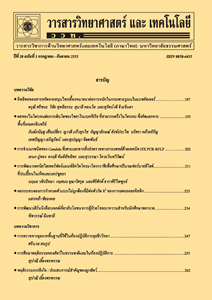The Testing of Compressive Strength from Oil Palm Bottom Ash Applied to Backfill in Petroleum Work
Main Article Content
Abstract
This research has proposed to investigate the basic properties of oil palm ash in order to utilize as backfill materials by using x-ray fluorescence (XRF) technique to analyze the elements, compressive strength, and density of mortar containing bottom ash from oil palm. In this experiment, cement was used as a supplementary material at 5, 10 and 15 % by weight for oil palm bottom ash, which was controlled in particle size distribution in various conditions, i.e. no incubation, and incubations at 7 and 28 days. The results of the analyses and experiments showed that oil palm bottom ash contained 26.71 % calcium oxide, resulting in pozzolan materials. The compressive strength was increased when adding cement. The oil palm bottom ash replacement with cement containing 15 % by weight at 28-day incubation has a compressive strength of 2.10 MPa. Besides, the increase in cement ratio affects the increase in the density of mortars. The density of oil palm bottom ash replacement with cement containing 15 % was 5605.10 kg/m3. The development of compressive strength of mortar at 28-day incubation will increase when the percentages of cement replacement in oil palm bottom ash increased. The compressive strength of mortar increases as the curing time increases.
Article Details
References
Niroj, N., 2014, Study on properties of leterite soil portland cement and slag mix as a pavement materials, Thai Sci. Technol. J. 4(1): 25-31. (in Thai)
Lohsomboon, P., Jirajariyavech, A., Silalert ruksa, W. and Preedaphatarapong, W., 2005, Database Preparation of Cycle Assessment in Cement and Steel Production for Environmental Management, The Thailand Research Fund (TRF), Bangkok.
Prachom, K., 2005, Properties of quarry dust for use as fine aggregate, Appl. Mech. Mater. 16(2): 1-5. (in Thai)
Mostafa, B., Fall, M. and Belem, T., 2004, A contribution to understanding the hardening process of cemented pastefill, Miner. Eng. 17: 141-152.
Mostafa, B., Fiset, J.F., Bussiere, B., Villeneuve, M. and Plante, B., 2006, Sludge recycling within cemented paste backfill: Study of the mechanical and leachability properties, Miner. Eng. 19: 420-432.
Piyang, T., Sagulsawasdipan, K. and Sawain, A., 2018, A study of palm oil fuel ash in manufacturing in production footpaths concrete stabs, Wichcha J. 37(1): 81-94. (in Thai)
Wongkeo, W., Thongsanitgarn, P., Pimraksa, K. and Chaipanich, A., 2012, Compressive strength, flexural strength and thermal conductivity of autoclaved concrete block made using bottom ash as cement replacement materials, Mater Design 35: 434-439.
Sinsiri, T., Kroehong, W., Jaturapitakkul, C. and Chindaprasirt, P., 2012, Assessing the effect of biomass ashes with different finenesses on the compressive strength of blended cement paste, Mater Design 42: 424-433.
Surin, M. and Teerawut, M., 2007, Influences of Palm Oil Fuel Ash from Upper Southern Part of Thailand on Properties of Mortar Portland Cement, Master Thesis, King Mongkut’s University of Technology Thonburi, Bangkok, 284 p.
Wanchok, K. and Apiwit, P., 2017, Mechanical properties, microstructure, thermal conductivity and drying shrinkage of cellular lightweight concrete containing bagasse ash, J. Ind. Tech. 13(2): 22-38. (in Thai)
Metwally, A., 2014, Compressive strength prediction of Portland cement concrete with age using a new model, HBRC 10: 145-155.
Malhotra, V.M. and Mehta, P.K., 1996, Pozzolanic and Cementitious Materials, Gordon and Breach Science Publishers, Amsterdam, 189 p.
Hewlett, P., 1998, Lea’s Chemistry of Cement and Concrete, 4th Ed., Edward Arnold, Ltd., New York City, NY., 845 p.
Naganathan, S., Razak, H. and Hamid S.N.A., 2012, Properties of controlled low-strength material made using industrial waste incineration bottom ash and quarry dust, Mater. Des. Eng. 33: 56-63.
Wu, W., Zhang, W. and Ma, G., 2010, Optimum content of copper slag as a fine aggregate in high strength concrete, Mater. Des. Eng. 31: 2878-2883.
Chindaprasirt, P., Jaturapitakkul, C. and Sinsiri, T., 2007, Effect of fly ash fineness on microstructure of blended cemented paste, Constr. Build Mater. 21: 1534-1541.
Samrej, S., 2013, Usage of Fly Ash for Manufacturing Interlocking Block, Master Thesis, Suranaree University of Techno logy, Nakhon Ratchasima, 52 p.
Runglawan, R. and Suksun, H., 2003, Consolidation and permeability characte ristics of cemented clays, Appl. Mech. Mater. 14(3): 25-31. (in Thai)


